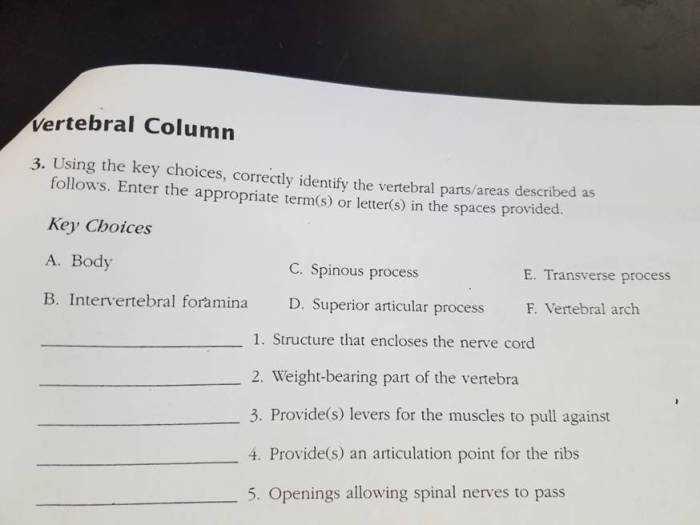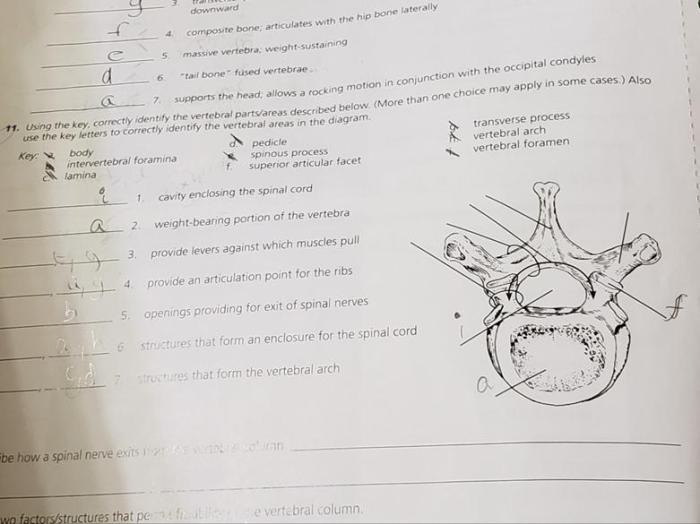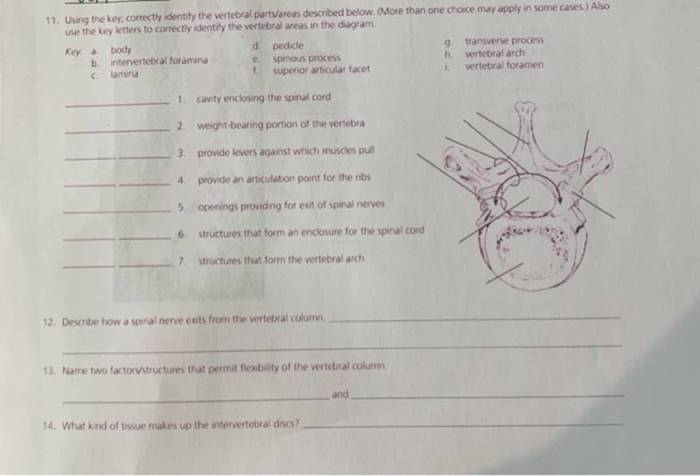Using the key correctly identify the vertebral parts/areas described below – Understanding the key to identifying vertebral parts and areas is crucial for a comprehensive understanding of spinal anatomy. This guide will provide a clear and concise overview of the key parts of a vertebra, their functions, and how to differentiate between them based on their anatomical features.
By utilizing this key effectively, readers will gain the knowledge and skills necessary to accurately identify vertebral structures, which is essential for accurate diagnosis and treatment planning in various spinal conditions.
The content of the second paragraph that provides descriptive and clear information about the topic
Understanding Vertebral Anatomy

The vertebral column, also known as the spine, is a complex structure composed of individual vertebrae stacked one upon another. Each vertebra serves a vital role in providing support, protection, and mobility to the body.
The key parts of a vertebra include the body, pedicles, laminae, and processes. The body, or centrum, forms the central weight-bearing portion of the vertebra. Pedicles are short, thick projections that extend from the body and connect to the laminae.
Laminae are flat plates that form the posterior portion of the vertebra, creating a protective canal for the spinal cord.
Processes are bony projections that extend from the vertebrae and serve various functions. Transverse processes extend laterally from the vertebrae and provide attachment sites for muscles and ligaments. Spinous processes project posteriorly and form the palpable bumps along the back.
Articular processes, located on the superior and inferior surfaces of the vertebrae, facilitate movement between adjacent vertebrae.
Identifying Vertebral Parts

Identifying vertebral parts based on their anatomical features is crucial for understanding their function and role in the spine.
The vertebral body is the largest and most prominent part, forming the cylindrical shape of the spine. Pedicles are short and stout projections located on the posterior aspect of the body, while laminae are broad, flat plates that extend posteriorly from the pedicles to form the vertebral arch.
Processes are categorized based on their direction and location. Transverse processes extend laterally, providing attachment sites for muscles and ligaments. Spinous processes project posteriorly and form the palpable bumps along the back. Articular processes, located on the superior and inferior surfaces of the vertebrae, facilitate movement between adjacent vertebrae.
- Body:Cylindrical, weight-bearing portion
- Pedicles:Short, thick projections from the body to the laminae
- Laminae:Flat plates forming the posterior vertebral arch
- Transverse Processes:Lateral projections for muscle and ligament attachment
- Spinous Processes:Posterior projections forming palpable bumps
- Articular Processes:Superior and inferior projections for movement between vertebrae
Variations in Vertebral Parts

Vertebral parts exhibit variations across different regions of the spine to accommodate specific functions.
- Cervical Vertebrae (Neck):Smaller bodies with large transverse foramina for nerve and blood vessel passage.
- Thoracic Vertebrae (Chest):Larger bodies with articular facets for rib attachment.
- Lumbar Vertebrae (Lower Back):Massive bodies and spinous processes for weight-bearing and mobility.
- Sacral Vertebrae (Pelvis):Fused to form the sacrum, providing stability and support for the pelvis.
- Coccygeal Vertebrae (Tailbone):Small, vestigial vertebrae forming the coccyx.
Clinical Significance of Vertebral Parts: Using The Key Correctly Identify The Vertebral Parts/areas Described Below
Understanding vertebral anatomy is essential in diagnosing and treating spinal conditions.
Herniated discs occur when the soft, jelly-like center of an intervertebral disc protrudes through a weakened disc wall, causing pain and nerve compression. Spinal stenosis refers to the narrowing of the spinal canal, which can compress the spinal cord and nerves.
Vertebral fractures, often caused by trauma, can result in pain, instability, and neurological deficits.
By identifying and understanding the specific vertebral parts involved in these conditions, healthcare professionals can accurately diagnose and develop appropriate treatment plans, including medications, physical therapy, or surgical interventions.
FAQs
What are the key parts of a vertebra?
The key parts of a vertebra include the body, pedicles, laminae, and processes.
How can I differentiate between pedicles and laminae?
Pedicles are located on the sides of the vertebral body and connect it to the laminae. Laminae are flat plates that form the roof of the vertebral foramen.
What is the clinical significance of understanding vertebral parts?
Understanding vertebral parts is crucial for accurate diagnosis and treatment planning of various spinal conditions, such as herniated discs, spinal stenosis, and fractures.